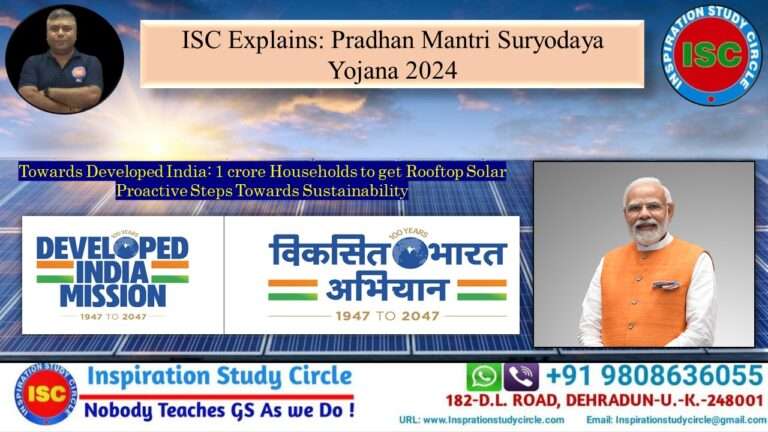
Inspiration Study Circle Explained: National Gopal Ratna Awards
The Department of Animal Husbandry and Dairying under the Ministry of Fisheries, Animal Husbandry and…
The Prime Minister, Shri Narendra Modi on 22nd January 2024 announced the ‘Pradhan Mantri Suryodaya Yojana’ under which 1 crore households will get rooftop solar.
PM Modi said “Today, on the auspicious occasion of the consecration of life in Ayodhya, my resolve has been further strengthened that the people of India should have their solar rooftop system on the roof of their houses. The first decision I have taken after returning from Ayodhya is that our government will launch “Pradhan Mantri Suryodaya Yojana” with the target of installing rooftop solar on 1 crore houses. This will reduce the electricity bill of the poor and middle-class making India self-reliant in the energy field.”

“सूर्यवंशी भगवान श्री राम के आलोक से विश्व के सभी भक्तगण सदैव ऊर्जा प्राप्त करते हैं।
आज अयोध्या में प्राण–प्रतिष्ठा के शुभ अवसर पर मेरा ये संकल्प और प्रशस्त हुआ कि भारतवासियों के घर की छत पर उनका अपना सोलर रूफ टॉप सिस्टम हो।
अयोध्या से लौटने के बाद मैंने पहला निर्णय लिया है कि हमारी सरकार 1 करोड़ घरों पर रूफटॉप सोलर लगाने के लक्ष्य के साथ “प्रधानमंत्री सूर्योदय योजना” प्रारंभ करेगी।
इससे गरीब और मध्यम वर्ग का बिजली बिल तो कम होगा ही, साथ ही भारत ऊर्जा के क्षेत्र में आत्मनिर्भर भी बनेगा।“
Pradhan Mantri Suryodaya Yojana is a visionary initiative aimed at providing electricity to households in India through Solar Rooftops. Focused on sustainability and self-sufficiency, the program encourages the generation of surplus electricity, which not only meets household energy requirements but also contributes to the national grid. This initiative not only reduces electricity consumption for households but also makes them self-sufficient in meeting their energy needs.
The Eligibility to apply for the Scheme includes the following terms”
Application Process:
Note: the complete eligibility criteria and application process shall be available on the designated portal, once the scheme is launched.
The initiative was officially launched with the ambitious goal of installing rooftop solar panels on 1 crore homes at a meeting chaired by the Prime Minister recently. This initiative not only reduces electricity consumption for households but also makes them self-sufficient in meeting their energy needs.
Prime Minister Modi highlighted the huge potential of solar energy and called for the launch of a national campaign to encourage residential users to adopt rooftop solar systems on a larger scale. By harnessing solar power from every rooftop, we can help India become a solar powerhouse, reducing its carbon footprint and dependence on non-renewable energy sources.
The deployment of solar roofs is an important step to promote sustainable development and benefit low-income groups. To complete this effort, it is recommended that institutional oversight be built at the city level and a strong road map be developed at the state level to ensure the effective implementation, strengthening, and support of this great initiative. One can focus on high maintenance costs and the implementation of rooftop solar will reduce these costs.
As the most populous country in the world, India has a huge potential to harness its human resources to bring about positive change. Prime Minister Modi’s recent announcement of ‘Pradhan Mantri Suryodaya Yojana‘ shows our commitment to renewable energy sources, especially solar power, to meet our energy needs while reducing environmental impact.
Prime Minister Suryodaya Yojana’s announcement was made by Prime Minister Modi at the Ayodhya Ram Mandir Consecration event. However, as per the latest information, the launch date of the scheme has not been given yet. It is important to stay updated on the launch date with official government announcements.
Disclaimer: The above article is based on information and statistics taken from various news portals.

The Department of Animal Husbandry and Dairying under the Ministry of Fisheries, Animal Husbandry and…

The center draws attention to anti-paper leak law amid the row of NEET and UGC NET exams: Rs 1 crore fine, up to 10 years in jail for offenders……

The Krishi Sakhi Program is an initiative implemented in various states of India to empower women …..
The Union Public Service Commission (UPSC) is all set to conduct its CSE Prelims Exam, tentatively on 26th May 2024…

The Union Public Service Commission (UPSC) released the results of the Prelims …

Union Public Service Commission (UPSC) has announced the Exam….